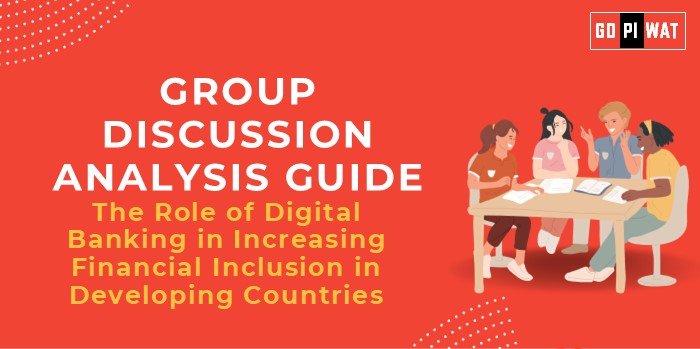📋 Group Discussion Analysis Guide: The Role of Digital Banking in Increasing Financial Inclusion in Developing Countries
🌐 Introduction to Digital Banking and Financial Inclusion
- 💡 Opening Context: “In developing countries, where traditional banking infrastructure is often inaccessible, digital banking has emerged as a transformative tool to bridge the financial inclusion gap, empowering millions through easy access to financial services.”
- 💻 Topic Background: Digital banking refers to providing banking services via electronic platforms, enabling users to perform transactions, access credit, and manage savings remotely. With over 1.4 billion unbanked adults globally, the adoption of digital banking platforms offers a pathway to financial inclusion, economic participation, and poverty alleviation.
📊 Quick Facts and Key Statistics
- 🌍 Global Unbanked Population: 1.4 billion adults lack access to banking services (World Bank, 2023).
- 📱 Mobile Money Impact: M-Pesa in Kenya has enabled financial access for over 60% of the adult population (GSMA, 2023).
- 📈 Account Ownership Growth: Digital banking has contributed to a 50% increase in account ownership in Sub-Saharan Africa (World Bank, 2023).
- 💰 Cost Efficiency: Digital banking reduces transaction costs by 80% compared to traditional methods (McKinsey, 2023).
👥 Stakeholders and Their Roles
- 🏛️ Governments: Create regulatory frameworks, support digital literacy initiatives, and promote infrastructure development.
- 🏦 Banks and Fintechs: Innovate user-friendly platforms and products tailored to underserved populations.
- 📡 Telecom Providers: Enhance internet and mobile coverage to facilitate digital banking access.
- 👥 Consumers: Benefit from affordable, accessible, and secure financial services.
🏆 Achievements and ⚠️ Challenges
Achievements:
- ✅ Financial Access Expansion: Platforms like M-Pesa and Paytm have significantly increased access to banking in Kenya and India, respectively.
- 💪 Economic Empowerment: Digital banking has enabled microcredit and savings for rural entrepreneurs and women.
- 📉 Cost Savings: By reducing reliance on physical branches, digital banking lowers operational costs, making services more affordable.
Challenges:
- 🌐 Digital Divide: Limited internet access and low smartphone penetration hinder adoption.
- 🔒 Cybersecurity Risks: Increased digital transactions have led to a rise in cybercrime.
- 🌎 Global Comparisons: While China excels with platforms like Alipay, regions like Sub-Saharan Africa face infrastructure deficits.
📋 Structured Arguments for Discussion
- 📈 Supporting Stance: “Digital banking empowers marginalized populations by providing cost-effective, accessible financial services, driving economic inclusion.”
- 📉 Opposing Stance: “While promising, digital banking’s impact is limited by infrastructure deficits, cybersecurity risks, and the digital divide.”
- ⚖️ Balanced Perspective: “Digital banking is a powerful tool for financial inclusion, but its success depends on robust infrastructure, regulatory frameworks, and digital literacy programs.”
💡 Effective Discussion Approaches
Opening Approaches:
- 📊 Statistical Highlight: “With over 1.4 billion unbanked adults globally, digital banking offers a transformative solution for financial inclusion.”
- 📖 Case Study Approach: “The success of M-Pesa in Kenya demonstrates how digital banking can drive financial inclusion in developing economies.”
Counter-Argument Handling:
- 💬 Counterpoint: “Concerns about cybersecurity can be addressed by adopting robust encryption technologies and consumer education.”
- 📚 Data-backed Rebuttal: “In India, UPI has facilitated over 11.5 billion monthly transactions, showcasing scalability and security in digital banking.”
🔍 Strategic Analysis of Strengths and Weaknesses
- ✨ Strengths: Enhances financial access, reduces costs, promotes entrepreneurship.
- ⚠️ Weaknesses: Requires internet infrastructure, faces cybersecurity threats, and suffers from low digital literacy.
- 🚀 Opportunities: Leverage mobile technology, integrate AI for personalized services, and expand rural outreach.
- ⛔ Threats: Digital fraud, exclusion of non-tech-savvy populations, and regulatory barriers.
📘 Connecting with B-School Applications
- 📚 Real-World Applications: Analyze case studies like M-Pesa, explore fintech innovations, and assess policy impacts on financial inclusion.
- 💬 Sample Interview Questions:
- 🔎 “How can digital banking overcome the digital divide in rural areas?”
- 🔎 “What role do fintech startups play in expanding financial inclusion?”
- ✨ Insights for B-School Students:
- 💼 Study the interplay between fintech innovation and financial literacy.
- 📈 Explore digital banking as a tool for economic empowerment in emerging markets.


